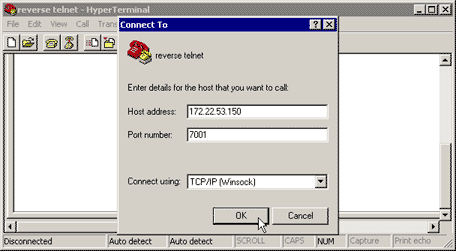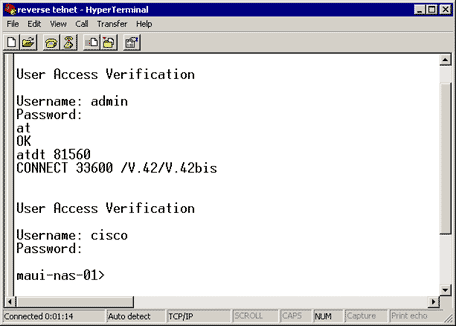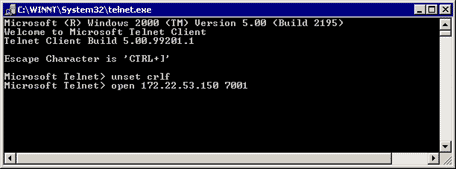Contents
Introduction
NetDialOut is software that allows desktop LAN users
to share network access server (NAS) ports as a modem
pool for outbound asynchronous communications. Users
of NetDialOut no longer need dedicated modems and phone
lines at their desktops, but instead use the communication
(COM:) port redirector software to allow dial ports
on the access servers to appear as local modems to desktop
communications applications. Windows users can dial
through a central NAS/access server to access remote
on-line services and even to send faxes from their PCs.
The Cisco IOS® Software Release running on
the NAS must support COM Port Control protocol (RFC
2217).
Hardware and Software Versions
NetDialOut requires that Cisco IOS Software version
12.0(9) or higher be installed on the NAS to be compatible..
Due to Bug CSCds28071, we recommend that you run Cisco
IOS Software version 12.1(8) or higher. If you are a
registered Cisco user you can get it by clicking Here
.
Installation and Configuration
Installing Appropriate Modem
Drivers for NetDialOut
- Install NetDialOut.
For complete NetDialOut installation information
on a client workstation, please refer to the NetDialOut
User Guide.
- Download Modem Drivers
The NetDialOut virtual COM ports do not have
any modem devices attached to them. The NetDialOut
user should use an appropriate .inf file for the
modems (install a modem driver on the virtual
COM ports). The MICA, NextPort and Microcom .inf
files are available for download from the Cisco
web site. For the other platforms use the specified
.inf files.
| Modem Type |
Platform |
.inf file |
| MICA |
3600, AS5200,AS5300,AS5800 |
mdcsmica.inf |
| NextPort |
AS5350,AS5400 AS5800, AS5850 |
| Microcom |
AS5200 |
mnpv90.inf |
| NM-xAM |
2600, 3600 |
Microcom DeskPorte V.34 FAST |
| WIC-xAM |
2600, 3600 |
mdmrock5.inf (or the standard
28800 bps modem file) |
Note: For Windows XP, the Cisco provided
.inf files may not work. Try using a Windows
built-in .inf file instead.
- Install Modem Drivers
To install a modem driver on the Windows PC, use
the following procedure:
- Start-->Settings-->Control
Panel -->Phone and Modem Options.
- Select Modem and Add to add a
new modem.
- Select Don't detect my modem; I will select
it from a list then click Next.
- Select the Manufacturer and Model of your modem.
Selecting Cisco on the left window displays Mica
on the right window.
- Select Have Disk and browse to the location
where the .inf file is saved.
- In the Selected ports option, use the
COM port selected during EZ Dialout installation
(for example, COM 5).
Configuring the Access Server
The IOS software configuration needed for character-mode
modem dialout applications only (such as with NetDialOut)
goes under the line configuration:
line starting_line_number ending_line_number
modem dtr-active
! -- If the router is for dialin & dialout use "modem inout" instead
transport input telnet
! -- Or transport input all could be used
escape-character NONE
! -- Due to Bug CSCdv12194 for the AS5350/AS5400.
rotary 1
! -- Specifies the use of TCP port 7001 in the NetDialOut manager
! -- window to dial out rotary 1
If external modems are used, then add the RS232 physical-layer
and framing parameters under the line configuration
as desired:
speed 115200
! -- Set to the highest speed supported by the modems
flowcontrol hardware
parity even
databits 7
! -- Or databits 8
stopbits 1
! -- Recommended for best throughput
If you want to control access to the dialout
lines, add the following in line configuration
mode:
password password
Alternatively, configure authentication, authorization,
and accounting (AAA) and apply the list to the
line with:
login authentication listname
If you wish to control which trunks are used for
the dialout calls, use the modem dialout controller command
introduced in Cisco IOS Sfotware Release 12.1(T)
(as of now, supported on the AS5300 only). For more
information, refer to the Cisco document Configuring
a T1 or E1 Interface for Outgoing Analog Calls Using
the modem dialout controller Command.
Tip: Sometimes NetDialOut can get confused
by the Password OK message from the IOS
software. To avoid this issue, configure AAA (local
or server-based) on the router. Refer to the AS5xxx with AAA section of this document for a sample configuration.
Optional: You can also configure a modemcap
to reset the modem to the default configuration
after each call. Use the command modem autoconfigure
type mica under the line configuration. This
modemcap (which sets factory default &F)
can be applied to all routers regardless of the
type of modem (MICA, NextPort, Microcom etc.). For
more information on modemcaps refer to the Cisco
document Recommended
Modemcaps for Internal Digital and Analog Modems
on Cisco Access Servers.
The same Access Server can be used for dialin as
well as dialout (application). For comprehensive
sample configurations refer to the section Sample NAS Configurations for the NetDialOut Utility.
Troubleshooting NetDialOut
Follow the method outlined below to troubleshoot
NetDialOut related issues:
- Reverse Telnet to the NAS modem from the NAS
exec prompt. Ensure you can connect to the modem
by issuing an AT command which should return
an OK response. If you can connect to the
modem, try to dial the number of the remote device
using the atdt ######## command.
If the connection is successful, then the router
configuration is correct and the hardware is working
correctly.
Note: Use the binary Telnet TCP port
range: 6000+line to use a specific line, or
7000+ rotary_number for a dialout rotary.
The example below shows a successful call:
maui-nas-03#telnet 172.22.53.150 7001
! -- Reverse Telnet to an up/up interface on the router
! -- and use port 7000+rotary
Trying 172.22.53.150, 7001 ... Open
User Access Verification
!
Username: admin
Password:
at
OK
! -- Modem is responding
atdt 81560
! -- Dial number 81560 to connect to remote device.
! -- This may take up to 30 seconds.
CONNECT 33600 /V.42/V.42bis
! -- Call is connected to the remote device.
User Access Verification
! -- Username prompt by remote device
Username: cisco
Password:
maui-nas-01>
If the reverse Telnet does not reach the modem
AT command mode, then the NAS is misconfigured.
Check the following:
- The interface whose IP address you're
Telnetting to should be up/up and pingable
from the PC host on the LAN. If you cannot
ping the router interface troubleshoot your
LAN for routing related issues.
- The modem line should have modem inout
(for dialin/dialout) or modem dtr-active
(for dialout only).
- The line should be configured with transport
input telnet or transport input all.
If the reverse Telnet succeeds in reaching
the modem AT command mode, but the manual call
fails, then the problem could be a Telco or
remote router issue. Troubleshoot the remote
router, the line and retest the connection before
proceeding further. Refer to Troubleshooting
Dial Technology Connectivity - Non-DDR Callout
for more information.
- Try a reverse Telnet from a PC host on the LAN.
Open Windows Hyper terminal (or Windows Telnet)
and Telnet to the router's IP address and the
port you are using for NetDialOut (for example
7001). If you can reach the modem and dialout,
then there is nothing wrong with the LAN (we had
previously verified that dialout from the NAS
is working).
- If the reverse Telnet does not reach the modem
AT command mode, then the NAS is misconfigured
or the IP network isn't working. Check the
following:
- The interface whose IP address you're
Telnetting to should be up/up and pingable
from the PC host on the LAN. If you cannot
ping the router interface troubleshoot your
LAN for routing related issues.
- There should be no access-class that is
blocking the Telnet connection.
The following screen captures show a successful
Hyperterminal session:


Note: If you are using the Microsoft
Windows Telnet client and AAA is configured
on the NAS, the windows Telnet login may fail.
This failure is caused by application settings
and is characterized by an inability to enter
the password, thus login fails. To correct the
Telnet application setting for this session,
follow the procedure below on the host PC:
- Start --> Run -->
type telnet, click OK.
- Type the unset crlf command. (This
ensures that you send a carriage returns as
Telnet <CR><NUL> rather than <CR><LF>.)
- Use open <ip_address> <port>
to Telnet to the modem.
- You should now be connected to the modems
and can now initiate the manual dial using
atdt just as with the Hyperterminal
example shows above. The following screen
capture is an example:

- Use Hyperterminal to directly connect to the
NAS modems via NetDialOut's emulated COM port.
Refer to the NetDialOut
User Guide chapter on installation for more
information. This will verify that NetDialOut's
emulated COM port is functioning.
-
If Hyperterminal over NetDialOut's emulated
COM port does NOT work, then the problem would
seem to be peculiar to NetDialOut's communication
with IOS. Gather the following information:
- These debugs determines if the NAS is receiving
the Telnet connection.
debug telnet
debug modem
- The NetDialOut Trace Log: Selecting the
Trace Window menu option opens the
NetDialOut Port Monitor window, with the Trace
Window tab enabled. To begin tracing,
check the Enable Trace box at the bottom
of this window. Make sure you save the log
for further analysis. Refer to the Troubleshooting
section of the NetDialOut User Guide for more
information.
- Since we have verified that NetDialOut can connect
to the modems, next have the end application initiate
a connection. If the end applications cannot talk
to each other using the NetDialOut connection,
then the problem could be peculiar to the end
application. The NetDialOut Trace Log may be useful
in troubleshooting this issue. Also turn on the
Windows TAPI modem log, and also any logging available
from the application. Refer to Microsoft's website for the following
Microsoft article: How to Create and Use the Modemlog.txt
File (Q142730) for more information.
If the operation still doesn't work as desired,
gather the IOS debugs, the NetDialOut Trace
Log, and (if applicable) the Windows modem log,
and analyze the results to determine where the
application is failing.
Refer to NetDialOut : User Guide
for additional information.
Sample NAS Configurations
for the NetDialOut Utility
AS25xx, NM-xAM, WIC-xAM
Following is a sample configuration file for routers
with external analog modems, such as Cisco AS2509,
Cisco AS2510, Cisco AS2511, or Cisco AS2512 access
server as well as routers with internal analog modems
(NM-xAM and the WIC-xAM) such as the 26xx, and 36xx
series routers.
The example below shows the router capable of incoming
and outgoing calls. If the router is for outbound
use only, then the line configuration is all that
is needed.
interface Group-Async1
! -- Group-Async interface used for dialin calls
! -- This is not used for dialout
ip unnumbered Ethernet0
no ip mroute-cache
encapsulation ppp
no ip route-cache
async default routing
async dynamic address
async mode interactive
peer default ip address pool local
dialer in-band
no cdp enable
ppp authentication chap
group-range 1 8
! -- Range of lines include 1 through 8
! -- Modems 1 through 8 can now be used for incoming or outgoing calls
!
line 1 8
! -- Line configuration used for NetDialOut
modem InOut
! -- Modem can be used for dialing and dialout
! -- If the line is used for dialout only use "modem dtr-active"
rotary 1
! -- The lines are placed in a rotary
! -- They are accessed by NetDialOut using port (7000 + rotary)=7001
transport preferred telnet
transport input all
! -- You could also use transport input telnet instead
rxspeed 115200
txspeed 115200
! -- Speed for external modems
! -- This is not needed for internal analog modems (NM-xAM, WIC-xAM)
flowcontrol hardware
! -- Flowcontrol for external modems
! -- This is not needed for internal analog modems (NM-xAM, WIC-xAM)
AS5xxx without AAA
Following is a sample configuration file for a
Cisco AS5xxx series access server without AAA.
This example shows the router accepting incoming
calls and making outbound calls.:
controller T1 0
! -- T1 interface used for incoming and outgoing calls
framing esf
clock source line primary
linecode b8zs
pri-group timeslots 1-24
!
interface Serial0:23
! -- D-channel configuration for T1 0
! -- This configuration is only needed for incoming calls
ip address 10.15.2.80 255.255.255.0
encapsulation ppp
no ip route-cache
no ip mroute-cache
no keepalive
dialer idle-timeout 400
dialer map ip 10.15.2.60 6661210
dialer-group 1
isdn incoming-voice modem
! -- Incoming analog calls will be switched to the modems
peer default ip address pool setup_pool
no fair-queue
no cdp enable
ppp authentication chap
ppp multilink
!
interface Group-Async1
! -- Group-async configuration for incoming calls
! -- This configuration is not used for outgoing calls
ip unnumbered Ethernet0
encapsulation ppp
no ip route-cache
no ip mroute-cache
async dynamic address
async dynamic routing
async mode interactive
peer default ip address pool setup_pool
ppp authentication chap pap
group-range 1 48
! -- Range of lines include 1 through 48
! -- Modems 1 - 48 can now be used for incoming or outgoing calls
!
line 1 48
! -- Line configuration for NetDialOut
exec-timeout 0 0
autoselect during-login
autoselect ppp
! -- The autoselect cmds are for protocol selection for incoming calls
! -- This is not needed if the router only makes outbound calls
modem InOut
! -- Modem can be used for dialing and dialout if the line is used for
! -- dialout only use, modem dtr-active transport preferred telnet
rotary 1
! -- The lines are placed in a rotary
! -- They are accessed by NetDialOut using port (7000 + rotary)=7001
transport input all
transport input telnet
! -- Configure one or both of the above commands
AS5xxx with AAA
Following is a sample configuration file for Cisco
AS5xxx series access servers with server-based AAA
configured.
The following example, shows an access server configured
for dialin and dialout calls:
aaa new-model
aaa authentication login default radius
! -- Use the radius server for login on the default list
! -- for local AAA replace "radius" with "local"
! -- (make sure to configure the username/password locally as well
aaa authentication ppp ppptac radius
! -- Use the radius server for ppp on the list named ppptac
! -- This is used for incoming ppp calls and is not used for
! -- outgoing NetDialOut calls
!
controller T1 0
! -- T1 interface used for incoming and outgoing calls
framing esf
clock source line primary
linecode b8zs
pri-group timeslots 1-24
!
interface Serial0:23
! -- D-channel configuration for T1 0
! -- This configuration is only needed for incoming calls
ip address 10.15.2.80 255.255.255.0
encapsulation ppp
no ip route-cache
no ip mroute-cache
no keepalive
dialer idle-timeout 400
dialer map ip 10.15.2.60 name test 5551210
dialer-group 1
isdn incoming-voice modem
peer default ip address pool setup_pool
no fair-queue
no cdp enable
ppp authentication chap ppptac
ppp multilink
!
!
interface Group-Async1
! -- Group-async configuration for incoming calls
! -- This configuration is not used for outgoing calls
ip unnumbered Ethernet0
encapsulation ppp
no ip route-cache
no ip mroute-cache
async dynamic address
async dynamic routing
async mode interactive
peer default ip address pool setup_pool
ppp authentication chap pap ppptac
! -- Use list named ppptac for authentication
group-range 1 48
! -- Range of lines include 1 through 48
! -- Modems 1 through 48 can now be used for incoming or outgoing calls
!
!
radius-server host 10.4.1.10
radius-server timeout 20
radius-server key nas1
! -- Radius server configuration
!
line 1 48
! -- Line configuration for NetDialOut as well as dialin calls
exec-timeout 0 0
autoselect during-login
autoselect ppp
! -- The autoselect cmds are for protocol selection for incoming calls
! -- This is not needed if the router only makes outbound calls
modem InOut
! -- Modem can be used for dialing and dialout
! -- If the line is used for dialout only, use modem dtr-active
! -- transport preferred telnet
rotary 1
! -- The lines are placed in a rotary
! -- They are accessed by NetDialOut using port (7000 + rotary)=7001
transport preferred telnet
transport input all
! -- You could also use transport input telnet instead
Related Information
Request
Technical Support
|
